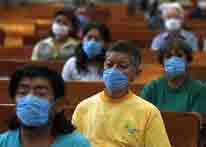Swineflu Update
Latest News Items
September 2010
International Situation
Swineflu Epedemic Officially Ends

The Swineflu Epidemic is Officially Over . . .
On August 10, 2010, the WHO Director-General, Dr. Margaret Chan, declared an end to the 2009 H1N1 influenza pandemic, but noted that 2009 H1N1 virus will likely continue to circulate for years to come, taking on the behavior of a seasonal influenza virus.
See how the situation has evolved since
January 2010.
GOT QUESTIONS ABOUT SWINEFLU - READ OUR FAQ.
The following report was created from a variety of sources, including regional WHO reports, Country reports, and CDC field staff updates. Updates are listed below under the appropriate region. It has been reproduced from the Centre for Disease Control Website, with certain additions to assist with their mission of informing the public about the evolution of this disease.
Global Flu Activity Update
Northern Temperature
United States
The numbers of laboratory positive influenza samples increased from week 33 to week 34, but remain at a very low level. In week 34, all influenza-positive samples were influenza A, with a mixture of A(H3) and 2009 H1N1 (based on U.S. WHO/National Respiratory and Enteric Virus Surveillance System (NREVSS) data).
China
In southern China, numbers of specimens testing positive for influenza decreased in week 33, and influenza A accounted for 82.9% of positive samples (67% H3N2, 25% 2009 H1N1). In northern China, positive influenza results have been low for several weeks, and influenza A accounted for 97.1% of positive samples (85% H3N2, 9% 2009 H1N1) (based on data provided by the Chinese National Influenza Center).
Southern Temperate
South America
In Argentina, positive respiratory specimens for influenza have decreased since week 24, and influenza B is the predominant influenza virus.In Chile, positive respiratory specimens for influenza increased in week 33, and flu-positives are a mix of influenza A and B (20% of influenza-positive samples are H3N2, 12% are 2009 H1N1, and 18% are influenza B, based on WHO Pacific American Health Organization (PAHO) data).
Africa
In South Africa, among samples tested through severe acute respiratory illness (SARI) surveillance, influenza positive samples increased from week 33 to 34, and the majority of positive samples are influenza B (based on South Africa National Institute for Communicable Diseases (NICD) data).
Tropical
Thailand
At Queen Sirikit Children’s hospital in Bangkok, rates of confirmed influenza among children 15 years and younger increased each week in August. Cases were predominantly influenza A (no subtype information) based on data collected through the International Emerging Infections Program (IEIP) and Global Disease Detection (GDD) Thailand).
Vietnam
Twice the proportion of influenza like illness (ILI) samples tested in-country in August were positive for influenza compared to July (87% of influenza-positive samples are A(H3), 12% are B, 1% 2009 H1N1, based on data reported by CDC field staff).
Vaccination Information
On February 18, 2010, WHO published recommendations for the following viruses to be used for influenza vaccines in the 2010-2011 influenza season of the Northern Hemisphere:
- an A/California/7/2009 (H1N1)-like virus;
- an A/Perth/16/2009 (H3N2)-like virus*;
- a B/Brisbane/60/2008-like virus.
- A/Wisconsin/15/2009 is an A/Perth/16/2009 (H3N2)-like virus and is a 2010 Southern Hemisphere vaccine virus.
The Center for Disease Contro (CDC) analyzes the situation on a weekly basis and you can read their latest update on swineflu
CLICK HERE .
For Answers to some Frequently Asked Questions about the H1N1 Virus
READ OUR FAQ.
(Source: Centre for Disease Control and Prevention. This report provides an update to the international flu situation using data reported by the World Health Organization (WHO) on September 3)
Top of Swineflu Update
Back to age-well.org
Enjoy this page? Please pay it forward. Here's how...
Would you prefer to share this page with others by linking to it?
- Click on the HTML link code below.
- Copy and paste it, adding a note of your own, into your blog, a Web page, forums, a blog comment,
your Facebook account, or anywhere that someone would find this page valuable.






